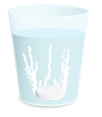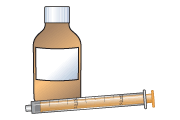Phosphate supplements for hypophosphataemia
This leaflet is for parents and carers about how to use this medicine in children. Our information may differ from that provided by the manufacturers, because their information usually relates to adults. Read this leaflet carefully. Keep it somewhere safe so that you can read it again.
Name of medicine
Phosphate (may also be called sodium phosphate, or neutral sodium phosphate)
Brand name: Phosphate-Sandoz
Why is it important for my child to take Phosphate?
The body needs phosphate to work properly, especially for healthy bones and teeth. Your child may have low phosphate levels because of either having too little phosphate in their diet (e.g. in premature babies) or losing too much phosphate (e.g. from the kidneys). Phosphate supplements help to increase the levels of phosphate in the blood.
What is Phosphate available as?
- Effervescent (fizzy) tablets: each tablet contains 16.1 mmol phosphate, 20.4 mmol sodium and 3.1 mmol potassium
- Liquid medicine can be ordered specially from your pharmacist. It contains a small amount of sugar. If you have any concerns or questions, speak with your child’s doctor, pharmacist or nurse.
When should I give Phosphate
Your child needs to have the right dose of phosphate each day, which may be in two, three or four divided doses. Your doctor will tell you how often to give it.
- Twice a day: this should be once in the morning and once in the evening. Ideally, these times are 10–12 hours apart, for example between 7 am and 8 am, and between 7 pm and 8 pm.
- Three times each day: this should be once in the morning, once in the early afternoon and once in the evening. Ideally, these times are at least 6 hours apart, for example 8 am, 2 pm and 8 pm.
- Four times a day: this is usually first thing in the morning, at about midday, late in the afternoon and at bedtime. Ideally, these times should be at least 4 hours apart, for example 8 am, midday, 4 pm and 8 pm.
Give the medicine at about the same times each day so that this becomes part of your child’s daily routine, which will help you to remember.
How much should I give?
The doctor will measure the level of phosphate in your child’s blood and adjust the dose of phosphate to get the levels in the blood right – they may change the dose with each visit. Your doctor, pharmacist or nurse will discuss this with you.
It is important that you follow your doctor’s instructions about how much to give.
How should I give Phosphate?

Effervescent tablets
- Effervescent tablets need to be dissolved in a glass of water or juice. Your child may only need some of this mixture.
- This must be measured using an oral syringe.
- Instructions on how to prepare this mixture and measure the right amount are available here: www.medicinesforchildren.org.uk/advice-guides/giving-medicines/how-to-give-phosphate-or-calcium-from-effervescent-tablets
- Your child should not chew these tablets.

Liquid medicine
- Shake the medicine well.
- Measure out the right amount using an oral syringe or a medicine spoon. You can get these from your pharmacist. Do not use a kitchen teaspoon as it will not give the right amount.
When should the medicine start working?
The medicine will start to work straight away but it may take 2–3 days before your child starts to feel better.
What if my child is sick (vomits)?
- If your child is sick less than 30 minutes after having a dose of Phosphate, give them the same dose again.
- If your child is sick more than 30 minutes after having a dose of Phosphate, do not give them another dose. Wait until the next normal dose.
If your child is sick again, seek advice from your family doctor, nurse, pharmacist, or hospital. They will decide what to do based on your child’s condition and the specific medicine involved.
What if I forget to give it?
Give the missed dose as soon as you remember. Try to give all the doses in one day, without doubling up. Make sure you leave at least two hours between doses.
What if I give too much?
You are unlikely to cause harm if you give an extra dose of Phosphate by mistake. If you are concerned that you may have given too much, contact your doctor or local NHS services (details at end of leaflet). Have the medicine or packaging with you if you telephone for advice.
Are there any possible side effects?
We use medicines to make our children better, but sometimes they have other effects that we don’t want (side-effects).
- Your child may have diarrhoea, stomach or abdominal cramps and may feel sick (nausea) or be sick (vomit) when they first start taking phosphate or if they have larger doses.
- Giving each dose with or after food may help. If it is still a problem after a week, contact your child’s doctor.
More information on side-effects can be found in the following leaflet http://www.medicinesforchildren.org.uk/side-effects-childrens-medicines
There may sometimes be other side effects that are not listed above. If you notice anything unusual and are concerned, contact your doctor. You can report any suspected side effects to a UK safety scheme at mhra.gov.uk/yellowcard
Can other medicines be given at the same time as Phosphate?
- You can give your child medicines that contain paracetamol or ibuprofen, unless your doctor has told you not to.
Check with your doctor or pharmacist before giving any other medicines to your child. This includes herbal and complementary medicines.
You should avoid giving your child any medicines that contain calcium, magnesium or aluminium (e.g. indigestion remedies / antacids) at the same time as giving Phosphate. Give at least two hours before or wait until at least two hours after giving Phosphate.
Is there anything else I need to know about this medicine?
When you get a new bottle of liquid medicine, check what strength you have been given and how much to give your child, as this may be different from the previous supply. If you are not sure how much to give, contact your doctor, pharmacist or nurse.
Liquid medicine may not keep for long once the bottle has been opened. Do not use the medicine past the expiry date.
General advice about medicines
- Try to give medicines at about the same times each day, to help you remember.
- Only give this medicine to your child. Never give it to anyone else, even if their condition appears to be the same, as this could do harm.
- If you think someone else may have taken the medicine by accident, contact your doctor or NHS local services (details at end of leaflet) for advice.
- Make sure that you always have enough medicine. Order a new prescription at least 2 weeks before you will run out.
- Make sure that the medicines you have at home have not reached the ‘use by’ date on the packaging. Give old medicines to your pharmacist to dispose of.
Where should I keep this medicine?
- Keep the medicine in a cupboard, away from heat and direct sunlight.
- You may need to keep liquid medicine in the fridge – check the instructions on the bottle. Make sure the medicine does not freeze.
- Make sure that children cannot see or reach the medicine.
- Keep the medicine in the container it came in.
Who to contact for more information?
England: NHS 111
Tel 111
www.nhs.ukScotland: NHS 24
Tel 111
www.nhs24.scotNorthern Ireland: NI Direct
Wales: NHS 111 Wales
Tel 111
www.111.wales.nhs.ukCopyright disclaimer
Version [2]. © NPPG, RCPCH and WellChild, all rights reserved. Review by April 2020.
The primary source for the information in this leaflet is the British National Formulary for Children. For details on any other sources used for this leaflet, please contact us through our website, www.medicinesforchildren.org.uk.
We take great care to make sure that the information in this leaflet is correct and up-to-date. However, medicines can be used in different ways for different patients. It is important that you ask the advice of your doctor or pharmacist if you are not sure about something. This leaflet is about the use of these medicines in the UK, and may not apply to other countries. The Royal College of Paediatrics and Child Health (RCPCH), the Neonatal and Paediatric Pharmacists Group (NPPG), WellChild and the contributors and editors cannot be held responsible for the accuracy of information, omissions of information, or any actions that may be taken as a consequence of reading this leaflet.
